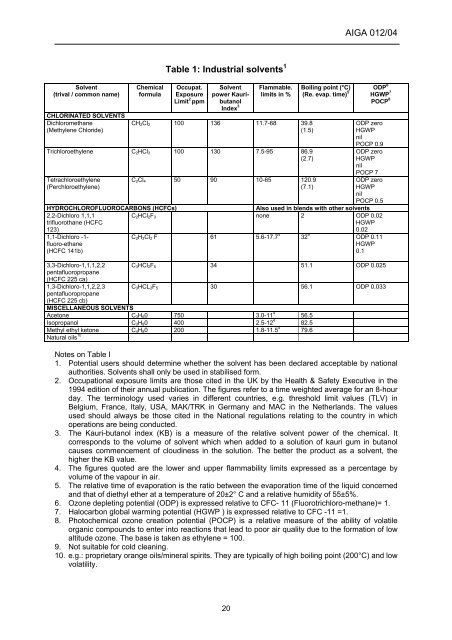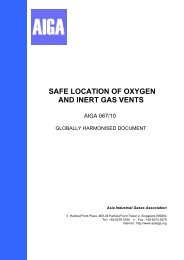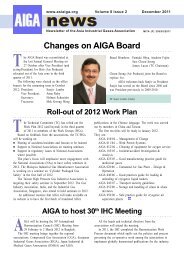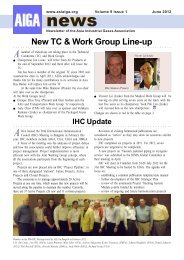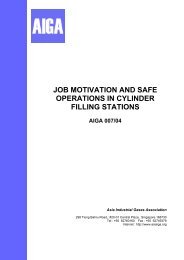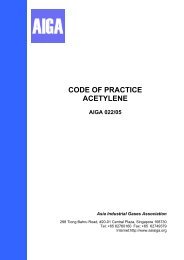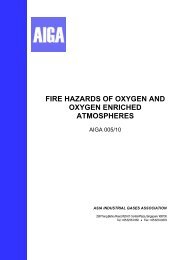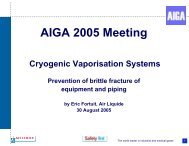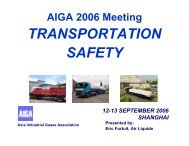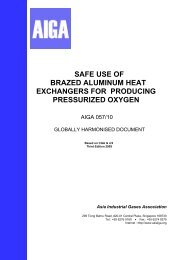CLEANING OF EQUIPMENT FOR OXYGEN SERVICE - AIGA
CLEANING OF EQUIPMENT FOR OXYGEN SERVICE - AIGA
CLEANING OF EQUIPMENT FOR OXYGEN SERVICE - AIGA
You also want an ePaper? Increase the reach of your titles
YUMPU automatically turns print PDFs into web optimized ePapers that Google loves.
Solvent<br />
(trival / common name)<br />
CHLORINATED SOLVENTS<br />
Dichloromethane<br />
(Methylene Chloride)<br />
Chemical<br />
formula<br />
Table 1: Industrial solvents 1<br />
Occupat.<br />
Exposure<br />
Limit 2 ppm<br />
Solvent<br />
power Kauri-<br />
butanol<br />
Index 3<br />
20<br />
Flammable.<br />
limits in %<br />
CH2Cl2 100 136 11.7-68 39.8<br />
(1.5)<br />
Trichloroethylene C2HCl3 100 130 7.5-95 86.9<br />
(2.7)<br />
Tetrachloroethylene<br />
(Perchloroethylene)<br />
C2Cl4 50 90 10-65 120.9<br />
(7.1)<br />
Boiling point (°C)<br />
(Re. evap. time) 5<br />
<strong>AIGA</strong> 012/04<br />
ODP 6<br />
HGWP 7<br />
POCP 8<br />
ODP zero<br />
HGWP<br />
nil<br />
POCP 0.9<br />
ODP zero<br />
HGWP<br />
nil<br />
HYDROCHLOR<strong>OF</strong>LUOROCARBONS (HCFCs) Also used in blends with other solvents<br />
2,2-Dichloro 1,1,1<br />
trifluorothane (HCFC<br />
123)<br />
1,1-Dichloro -1fluoro-ethane<br />
(HCFC 141b)<br />
3,3-Dichloro-1,1,1,2,2<br />
pentafluoropropane<br />
(HCFC 225 ca)<br />
1,3-Dichloro-1,1,2,2,3<br />
pentafluoropropane<br />
(HCFC 225 cb)<br />
POCP 7<br />
ODP zero<br />
HGWP<br />
nil<br />
POCP 0.5<br />
C2HCl2F3 none 2 ODP 0.02<br />
HGWP<br />
0.02<br />
C2H3Cl2 F 61 5.6-17.7 4 32 9 ODP 0.11<br />
HGWP<br />
0.1<br />
C3HCl2F5 34 51.1 ODP 0.025<br />
C3HCL2F5 30 56.1 ODP 0.033<br />
MISCELLANEOUS SOLVENTS<br />
Acetone C3H60 750 3.0-11 4 56.5<br />
Isopropanol C3H80 400 2.5-12 4 82.5<br />
Methyl ethyl ketone C4H80 200 1.8-11.5 4 79.6<br />
Natural oils 10<br />
Notes on Table I<br />
1. Potential users should determine whether the solvent has been declared acceptable by national<br />
authorities. Solvents shall only be used in stabilised form.<br />
2. Occupational exposure limits are those cited in the UK by the Health & Safety Executive in the<br />
1994 edition of their annual publication. The figures refer to a time weighted average for an 8-hour<br />
day. The terminology used varies in different countries, e.g. threshold limit values (TLV) in<br />
Belgium, France, Italy, USA, MAK/TRK in Germany and MAC in the Netherlands. The values<br />
used should always be those cited in the National regulations relating to the country in which<br />
operations are being conducted.<br />
3. The Kauri-butanol index (KB) is a measure of the relative solvent power of the chemical. It<br />
corresponds to the volume of solvent which when added to a solution of kauri gum in butanol<br />
causes commencement of cloudiness in the solution. The better the product as a solvent, the<br />
higher the KB value.<br />
4. The figures quoted are the lower and upper flammability limits expressed as a percentage by<br />
volume of the vapour in air.<br />
5. The relative time of evaporation is the ratio between the evaporation time of the liquid concerned<br />
and that of diethyl ether at a temperature of 20±2° C and a relative humidity of 55±5%.<br />
6. Ozone depleting potential (ODP) is expressed relative to CFC- 11 (Fluorotrichloro-methane)= 1.<br />
7. Halocarbon global warming potential (HGWP ) is expressed relative to CFC -11 =1.<br />
8. Photochemical ozone creation potential (POCP) is a relative measure of the ability of volatile<br />
organic compounds to enter into reactions that lead to poor air quality due to the formation of low<br />
altitude ozone. The base is taken as ethylene = 100.<br />
9. Not suitable for cold cleaning.<br />
10. e.g.: proprietary orange oils/mineral spirits. They are typically of high boiling point (200°C) and low<br />
volatility.


